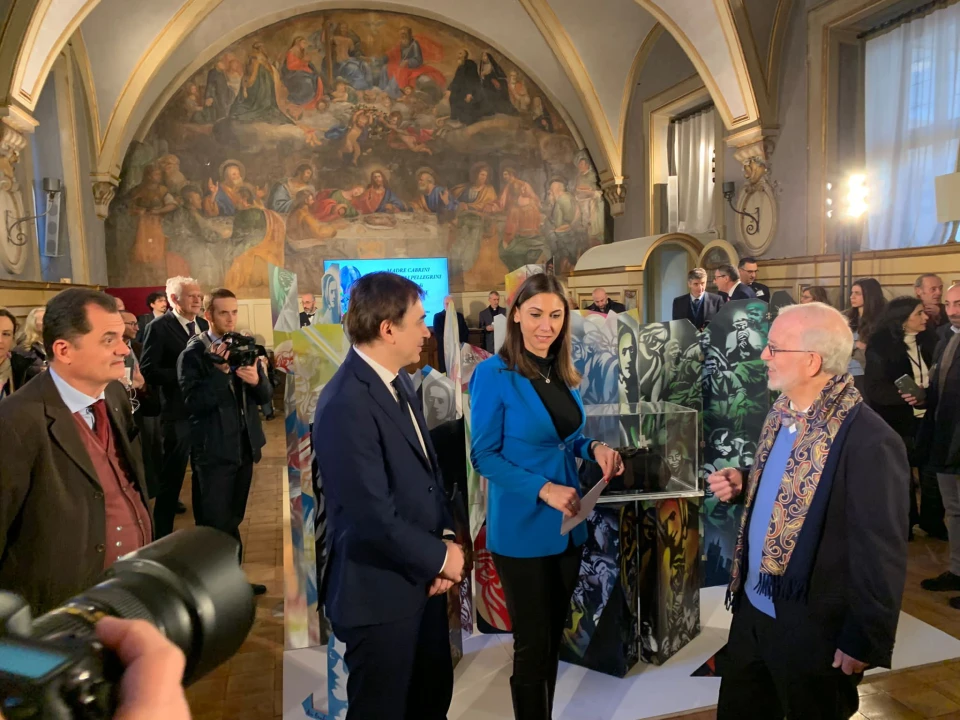On Jan. 30, thanks to an initiative organized by the Hon. Christian Di Sanzo, elected in North and Central America, the Sala del Cenacolo at the Vicolo Valdina Complex, in the heart of Rome, was inaugurated the exhibition "Mother Cabrini and the Pilgrim Angels" curated by master Meo Carbone, a prominent figure in the Italian Community of Chicago.
Carbone's works depict St. Frances Cabrini in her mission among Italian migrants in the United States, contributing to building important pages of our migratory history. The inauguration was attended, along with Hon. Christian Di Sanzo, by Hon. Anna Ascani (Vice-President of the Chamber of Deputies), Hon. Federico Mollicone (Chairman of the Culture Commission) and the author of the works on display, Maestro Meo Carbone.
Hon. Di Sanzo, thanking Hon. Ascani and Hon. Mollicone for their attention to the exhibition, highlighted how Mother Cabrini's pioneering action "contributed to changing America with a bottom-up action, sometimes being the voice of those many migrants in America who had remained on the margins of society instead of finding a place where they could realize their dream of a life far from poverty."
Mother Cabrini - according to Di Sanzo - gave Italian migrants first of all hope and also a dignified welcome, care for those who were sick, and a progressive insertion into society with special attention to women and the promotion of their dignity. Mother Cabrini understood that the world was changing and that migratory flows would characterize the new society that was coming into being, anticipating what later became the great Italian migration in the world." Hon. Di Sanzo stressed that Mother Cabrini's story is intrinsically linked to emigration to the Americas, highlighting her commitment to supporting Italians in need in the United States. "In addition to material assistance, Mother Cabrini contributed significantly to integration through language classes, bureaucratic assistance, and maintaining ties with families of origin. Her constant efforts against racial discrimination and for the improvement of conditions for Italian women left a lasting impression on the Italian-American community."
"Carbone's works," for Hon. Di Sanzo, "allow us to understand the context in which the Italians of the first emigration to the U.S. found themselves and the great work of Santa Cabrini, reminding everyone of the significance of emigration in Italian history.
The Hon. Ascani, Vice-President of the Chamber, also thanked Maestro Carbone for his valuable work in making the figure of Mother Cabrini known, recalling that "the example of Mother Cabrini can and must still be an inspiration today in addressing with intelligence and humanity the issue of the great migrations. With the conviction that the encounter between peoples can and must enrich everyone through dialogue, solidarity, inclusion and the rejection of prejudice and discrimination." The vice president of the Chamber, moreover, drew attention to the female figure of Mother Cabrini, emphasizing that "she was a missionary but above all a woman who was able to anticipate the times, not only with regard to the phenomenon of migration, but also by demonstrating the feminine ability to change - with courage, diplomacy and creativity - her own reality and that of others."
Hon. Mollicone in her speech highlighted the fact that anta Francesca Cabrini is the "missionary nun who symbolized the hope and dreams of Italian emigrants in the United States." "Mother Cabrini," for Hon. Mollicone, "played a central role in the growth of the Italian community in the United States and in many other parts of the world. She crossed the lands of Central America, Brazil, Argentina, Europe and the United States by train and even on foot, founding a total of 67 institutes including schools, hospitals and orphanages."
The exhibition will remain open to the public until Feb. 8 at the Complex of the Chamber of Deputies in Vicolo Valdina (Piazza di Campo Marzio, 42, Rome) with entrances from 11 a.m. to 7:30 p.m., last entry at 7 p.m.



